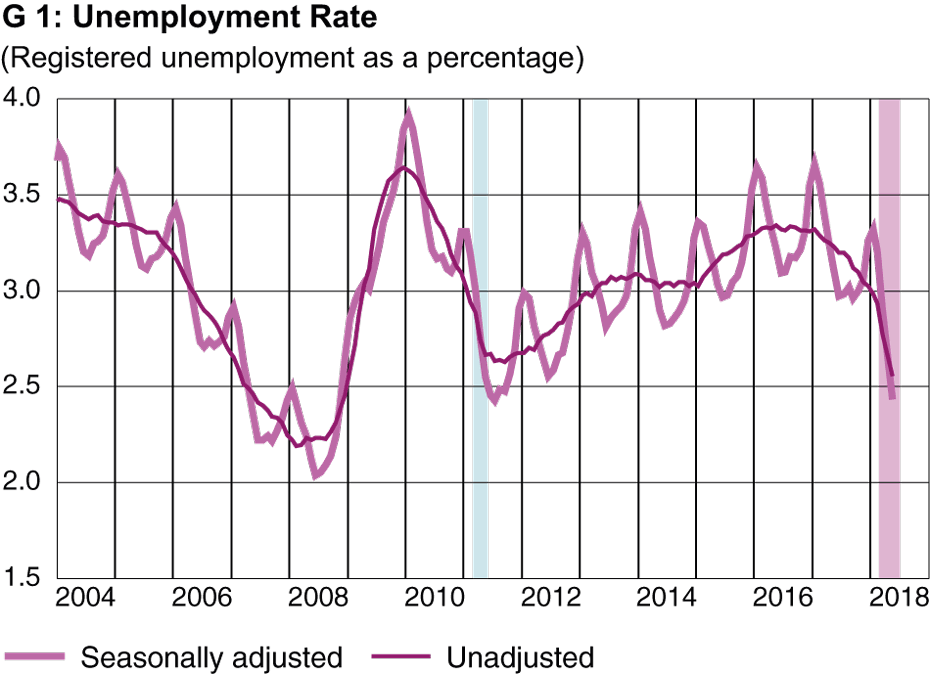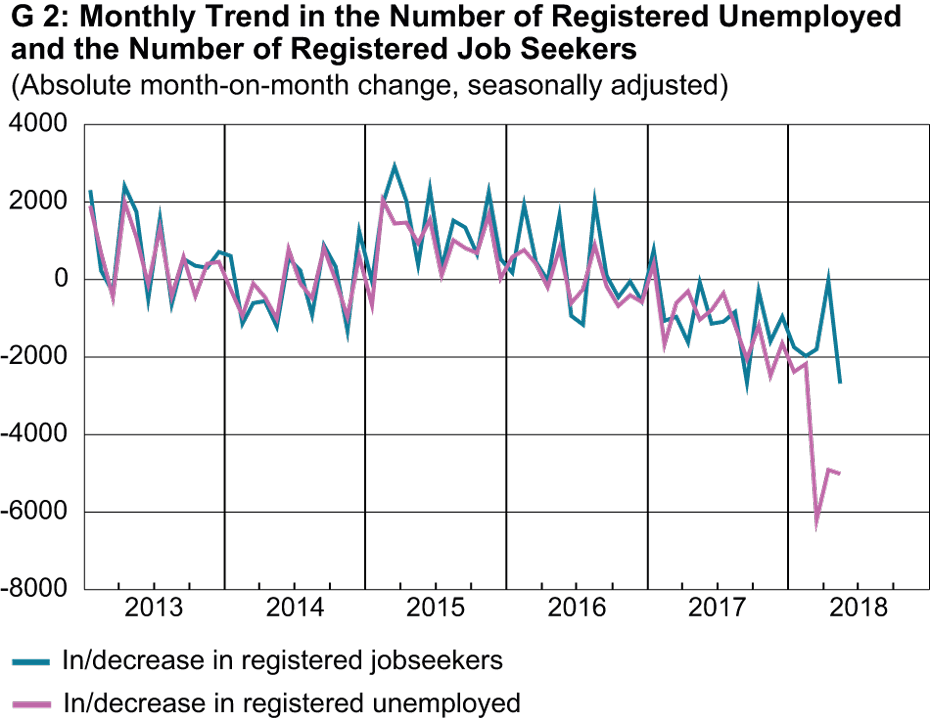Unemployment at Record Low – Is It Really True?
- Labour Market
- Swiss Economy
- KOF Bulletin
‘Unemployment in Switzerland drops to 2008-levels’ - headlines like this have done the rounds after the Swiss State Secretariat for Economic Affairs (SECO) presented its latest unemployment figures at the beginning of the month. Regrettably, however, the situation on the labour market is not (yet) as rosy as it was in early 2008. The new unemployment figures are not comparable with the historic figures.
According to the latest SECO unemployment figures, the Swiss labour market is in an enviable state. As shown by Graph 1, seasonally adjusted unemployment amounted to just under 2.50%. This is the lowest rate since early 2008 when the Swiss economy was in an excellent state at the tail end of a lengthy boom. Between March and May of this year alone, the overall Swiss unemployment rate declined from 2.9% to 2.6% on a seasonally adjusted basis. Com-ments in the Swiss media were jubilant. ‘Unemployment at lowest level in 10 years’, wrote the Blick daily. However, the current unemployment figures, which are indeed very low, are not comparable to those published 10 years ago.

Stricter unemployment insurance rules reduce unemployment
There are two reasons responsible for this. The first is the unemployment insurance reform of March 2011. As part of the restructuring of the unemployment insurance system, the reform also involved restrictions applying to various population groups. For instance, the maximum entitlement to daily unemployment benefit of childless jobseekers under 25 was cut by 50%, and a special waiting period was introduced for students in order to raise the barrier to reg-istration with regional employment offices (RAV). These changes affect the SECO unemployment figures, which now only include unemployed individuals who actually reg-ister with an employment office. For some population groups, the reform reduced the incentive to register with a RAV. On top of this, benefit periods were cut, resulting in numerous long-term unemployed being disqualified and losing their entitlement to benefits. In most cases, these disqualified unemployed disappear from the SECO unem-ployment statistics.
How did the reform affect the recorded unemployment rate? A look at the number of people who were disqualified due to the changes may provide a possible answer to this question. In March 2011, around 16,000 long-term unem-ployed were disqualified – approximately 12,500 more than in the months before and after. Taking this figure as the starting point, the legislative amendment permanently reduced the recorded unemployment rate by around 0.2 percentage points.1
Jobseekers on employment and training programmes are not included in the unemployment rate
Furthermore, the new registered unemployment figures are not directly comparable to the 2008 figures since SECO has also converted its processing of the unemployment data in March of this year. Individuals registering with an employment office are now divided into ‘unemployed’ job-seekers and ‘not unemployed’ jobseekers. This breakdown has been introduced since it is common international prac-tice to include only those who are available to take up a new job on short notice in the unemployment statistics. Hence, a relatively large number of people who register with RAVs do not count as unemployed. This includes, for instance, jobseekers who have been assigned to active labour mar-ket integration measures, such as employment pro-grammes or qualification courses, as well as jobseekers who are entitled to unemployment benefit after a dismissal but have not yet completed their notice period. Up until now, the breakdown into unemployed and not unemployed jobseekers was based on assessments by the RAV staff. Now, SECO divides jobseekers into unemployed and not unemployed on a semi-automatic basis. This conversion raises the significance of the unemployment figures since the breakdown method is more reliable.
Technical changes reduce recorded unemployment figures
How would the unemployment figures have developed in the last three months if the recording method had not changed? Again, the current system is too new to allow for an accurate answer. However, the trend in registered job-seekers between March and May provides certain insights. It is likely that the change in method has predominantly affected the breakdown into unemployed and not unem-ployed jobseekers, but not the overall number of jobseek-ers. Graph 2 juxtaposes the trend in the number of regis-tered unemployed with the number of registered job seekers. The Graph presents the absolute change in seasonally adjusted figures over the previous month. For the present, it shows that normally both rows follow a very similar trend. However, this has not been the case in the last three months. In these three months, the number of registered unemployed dropped by around 16,000: 6,000 in March and approximately 5,000 each in April and May. However, in the same period the seasonally adjusted number of registered jobseekers declined by no more than around 4,500. At face value, these figures indicate that approximately two-thirds of the decline in unemployment in the last three months is due to the change in method. According to this simple esti-mate, the unemployment rate today would be 0.15 to 0.3 percentage points higher if the system had not been adjust-ed. It should be noted that further changes in the recording method are planned in June, which will lead to a slight increase in unemployment figures. These changes should therefore reduce the impact of the system conversion to some extent.

Unemployment rate pursuant to ILO corrects over-optimistic labour market perception
Without the unemployment insurance reform and the tech-nical conversion of the unemployment measurement meth-od, recorded unemployment would now be higher. Accord-ing to our rough calculations, the seasonally adjusted unemployment rate would range between 3.0 and 3.2% – approximately half a percentage point higher than the cur-rent figures. The unemployment statistics according to the International Labor Organization (ILO), which are known as jobless statistics in Switzerland, show that there are still numerous people looking for jobs despite the positive start to the year. In contrast to the SECO statistics of registered unemployed, the ILO figures also include the unemployed who are not registered with the employment office. In the first quarter of 2018, on a seasonally adjusted basis, these figures remained close to 5% and declined very little in the last quarters. Historically, this level of unemployment is rather high for Switzerland. However, the substantial increase in employment in the first quarter of 2018 raises hopes for an actual drop in unemployment in the coming months.
1 If the unemployment insurance reform had affected the behaviour of newly unemployed jobseekers – specifically their success in finding a job – the effect could have been temporary instead of permanent. However, according to a study by Arni and Schiprowski (2016), this does not appear to be the case.
Contact
KOF Konjunkturforschungsstelle
Leonhardstrasse 21
8092
Zürich
Switzerland